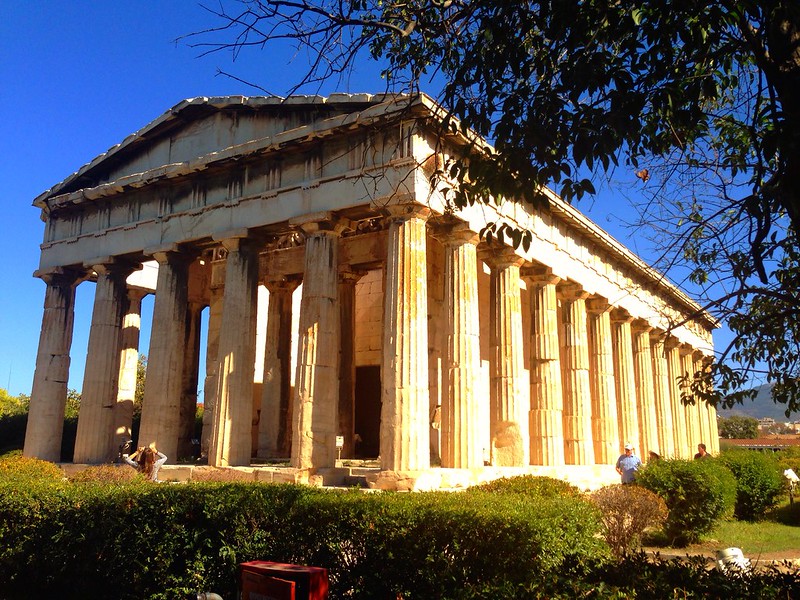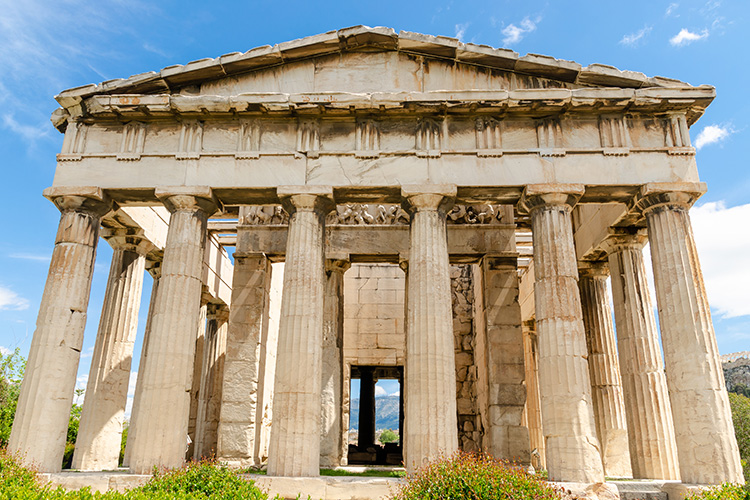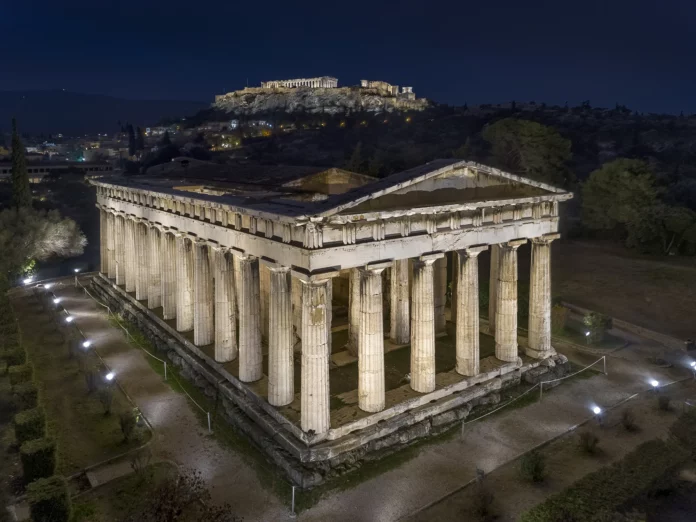The Temple of Hephaestus, also known as Hephaisteion or Hephaesteum, stands as a testament to the architectural brilliance of ancient Greece. Situated on the north-west side of the Agora of Athens atop the Agoraios Kolonos hill, this well-preserved Doric peripteral temple has a rich history that reflects its varied uses over the centuries. Dedicated to Hephaestus, the god of metalworking, craftsmanship, and fire, the temple remains largely intact, offering insights into ancient Greek religion, architecture, and culture.
Historical Significance

Dedication to Hephaestus
Hephaestus, the patron god of metalworking and craftsmanship, was honored by the numerous potters’ and metal-working shops surrounding the temple. Archaeological evidence suggests that a small sanctuary existed on the site before being burned during the Second Persian invasion of Greece in 480 BCE. The temple we see today began construction in 449 BCE under the vision of Pericles, aimed at transforming Athens into a cultural and political powerhouse.
Misidentification as the Temple of Theseus
For many years, the Temple of Hephaestus was mistakenly identified as the Theseion, believed to house the remains of the Athenian hero Theseus. This misidentification persisted until inscriptions within the temple confirmed its dedication to Hephaestus. The misconception arose from the historical context of Theseus’ remains being brought back to Athens from Skyros by Kimon in 475 BCE.
Construction and Architectural Features
The construction of the Temple of Hephaestus spanned several decades, beginning in 449 BCE and experiencing interruptions as funds and workers were diverted to the Parthenon. The western frieze was completed between 445–440 BCE, with further significant additions made between 435–430 BCE. The temple features a pronaos, a cella housing cult images, and an opisthodomos. Unique to its design is the alignment of the antae of the pronaos with the third flank columns of the peristyle, a characteristic of mid-5th century BCE architecture.
Architectural Marvels
Sculptural Decorations
The decorative sculptures of the Temple of Hephaestus demonstrate a blend of Doric and Ionic styles. The pronaos and opisthodomos are adorned with continuous Ionic friezes, depicting scenes such as the battle of Theseus with the Pallantides and the battle of Centaurs and Lapiths. The east pediment showcases the Birth of Athena, while the west pediment illustrates the Return of Hephaestus to Olympus. The temple’s metopes, especially on the east side, feature the Labours of Heracles and Theseus.
Use of Materials
Constructed primarily from marble sourced from Mt. Penteli, with the bottom step of the krepis made from a different stone, the Temple of Hephaestus highlights the sophisticated use of local materials. The architectural sculpture incorporates both Pentelic and Parian marble, reflecting the high craftsmanship of the period.
Evolution of the Temple

Transformation into a Christian Church
Around the 7th century CE, the temple was converted into a Christian church dedicated to Saint George Akamates. The name “Akamates” has various proposed origins, including derivations from the name Akamantas, son of Theseus, or from the Greek word for “loiterer,” referencing the church’s infrequent use during the Ottoman era.
Role in Modern Greek History
The Temple of Hephaestus played a significant role in modern Greek history. In 1834, when Athens became the capital of Greece, the temple was used to announce the royal edict. It served as a burial site for non-Orthodox Europeans, including notable philhellenes who supported Greek independence. Among those buried was John Tweddel, a friend of Lord Elgin. In 1834, King Otto I transformed the temple into a museum, a role it held until 1934, after which it became an ancient monument and underwent extensive archaeological research.
Conclusion
The Temple of Hephaestus stands as a remarkable relic of ancient Greek architecture and history. Its preservation over the centuries, through its varied uses as a church, museum, and archaeological site, underscores its significance. Dedicated to the god of craftsmanship and fire, the temple not only represents the religious devotion of ancient Athenians but also their architectural ingenuity. Today, it remains a symbol of Athens’ rich historical and cultural heritage.
